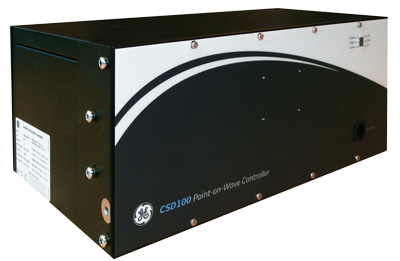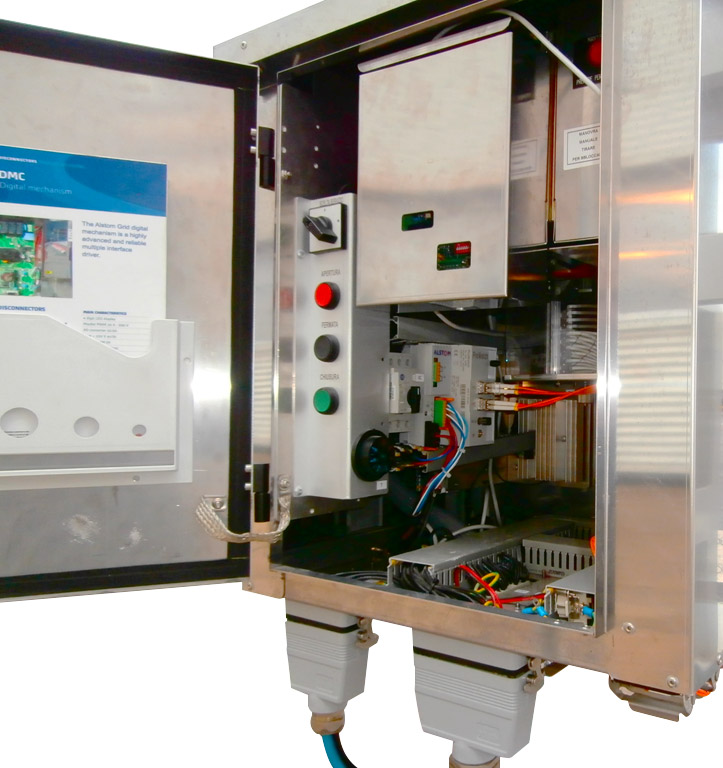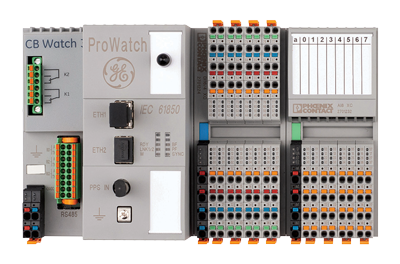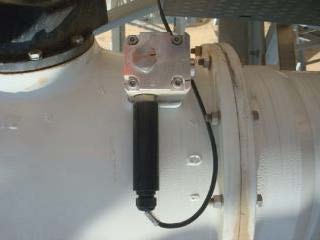CSD100
Point-on-Wave Controller
Point-on-wave switching is a technique consisting in operating AC system switchgear / circuit-breaker at optimum time to reduce switching transients
GE Vernova’s CSD100 is an advanced Controlled Switching Device for high voltage AC circuit-breakers. The ability to mitigate switching transients is becoming a key issue for today’s grids as the generated stresses lead to power quality problems and accelerated aging.
CSD100, associated with circuit-breakers, provides utilities with a cost-effective, streamlined solution to protect utility assets and improve system reliability by minimizing risks and operation costs.
CSD100 is able to intercept operation orders, compute optimal targets, and drive the circuit breaker actuators, thanks to dedicated system voltage and current inputs as well as power outputs. By doing so, a slight delay (some tens of milliseconds) is applied.
CSD100 is able to extend asset lifetime by limiting switching transients and consequent stress applied on equipment using controlled switching technique.
CSD100 is applicable for
- Safe connection of intermittent power generation sources
- Safe switching of reactive power compensation
- Safe switching of long overhead lines
- Easy replacement of RPH2 and RPH3 point of wave controllers
Benefits:
- Improved power quality and network stability
- Limited stress on grid equipment for an extended asset life
- Combined data acquisition and digital communication for enhanced asset performance management (APM)
CSD100
Point-on-Wave Controller
Point-on-wave switching is a technique consisting in operating AC system switchgear / circuit-breaker at optimum time to reduce switching transients
GE Vernova’s CSD100 is an advanced Controlled Switching Device for high voltage AC circuit-breakers. The ability to mitigate switching transients is becoming a key issue for today’s grids as the generated stresses lead to power quality problems and accelerated aging.
CSD100, associated with circuit-breakers, provides utilities with a cost-effective, streamlined solution to protect utility assets and improve system reliability by minimizing risks and operation costs.
CSD100 is able to intercept operation orders, compute optimal targets, and drive the circuit breaker actuators, thanks to dedicated system voltage and current inputs as well as power outputs. By doing so, a slight delay (some tens of milliseconds) is applied.
CSD100 is able to extend asset lifetime by limiting switching transients and consequent stress applied on equipment using controlled switching technique.
CSD100 is applicable for
- Safe connection of intermittent power generation sources
- Safe switching of reactive power compensation
- Safe switching of long overhead lines
- Easy replacement of RPH2 and RPH3 point of wave controllers
Benefits:
- Improved power quality and network stability
- Limited stress on grid equipment for an extended asset life
- Combined data acquisition and digital communication for enhanced asset performance management (APM)
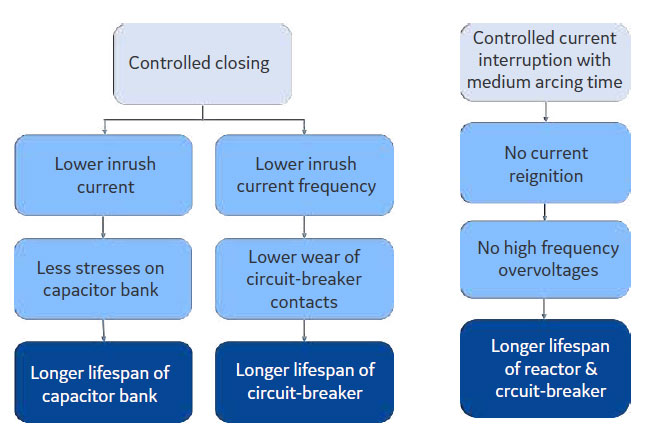 CSD100 Operation Cycle
CSD100 Operation Cycle
Controlled Switching of Load compensation
CSD100 is an advanced controlled switching device for high voltage AC circuit-breakers for any kind of application.
Challenges
Intermittent power sources generate important daily load variations. Capacitor banks and shunt reactors help stabilize and improve the power factor. Acting as reactive power generators, their switching needs to be controlled precisely to mitigate the related electrical transients. It allows to limit damageable stress on the circuit-breaker and the compensation load.
Reactive Power Compensation in Safe Conditions
CSD100, used with GE Vernova's advanced circuit-breakers, is a cost-effective solution to reduce stress on reactive power compensation equipment and increase their lifetime.
Benefit :
- Safe switching in reactive power compensation
- Drastic reduction of electrical transients
- Drastic reduction of stress on equipment
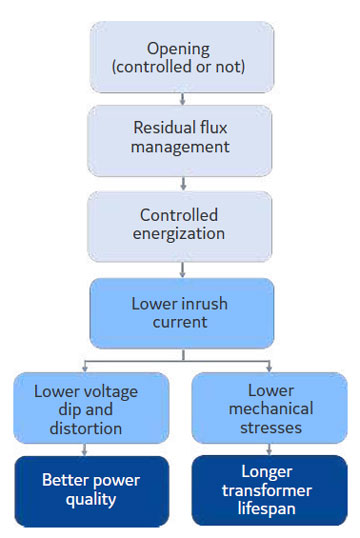 CSD100 Operation Cycle
CSD100 Operation Cycle
Controlled Switching of Overhead Lines
CSD100 is an advanced controlled switching device for high voltage AC circuit-breakers for any kind of application.
Challenges
Connecting and disconnecting intermittent power sources -such as wind or solar farms, pumped storage or gas power plants- to the country grid may generate switching transients with damageable consequences for the transformer and the power quality (high inrush currents, voltage dip, protection trip).
Safe Connection of the Transformers to the Grid
CSD100 reduces power transformer inrush current and voltage deep by energizing each phase (winding) at magnetic flux continuity condition, considering the transformer core residual flux.
CSD100 takes into consideration the transformer magnetic flux in order to switch and connect the transformer to the lines when the source flux matches the transformer residual flux. The inrush current and voltage dip are minimized. The power quality is improved, the transformer lifetime is extended.
Benefits:
- Safe connectivity of intermittent generation
- Voltage dip reduction
- Inrush current mitigation
- Transformer stress limitation
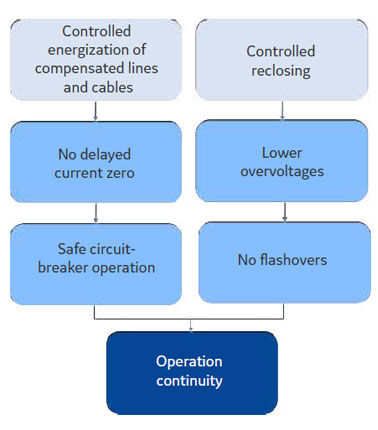 CSD100 Operation Cycle
CSD100 Operation Cycle
Controlled Switching of Overhead Lines
CSD100 is an advanced controlled switching device for high voltage AC circuit-breakers for any kind of application.
Challenges
Power generation sources are often located far from main consumption areas. As a result, large amounts of energy need to be transmitted over long distances. The random circuit- breaker switching of no-load lines generates a travelling voltage wave which, provokes an over-voltage along the length of the line. Also, auto-reclosing of the line circuit-breaker may cause even larger over-voltages than simple closing due to trapped charge on the line.
Safe Switching of Overhead Lines
CSD100 is a cost-effective solution to limit overvoltage during closing and auto-reclosing of line circuit-breakers.
CSD100 helps to optimize line design and could generate important savings at the conception stage. The value of over-voltages directly determines the insulation and protection levels of the lines, as well as their cost.
Securing Your Primary Equipment
- With extensive data acquisition and storage capabilities, the CSD100 allows for extensive monitoring and optimized switching in order to protect equipment. Together, with its digital communication abilities, the CSD100 plays a key role in your asset performance management strategy
- CSD100’s design simplifies substation integration
- Built-in cybersecurity features, in line with the latest NERC, IEC, and IEEE standards, ensure a high security level
Benefits:
- Improved overhead lines and cables management
- Safe closing and auto-reclosing
- Optimization of insultation levels
- Optimization of overhead lines designs
- Reduction of surge arrestor stress
Controlled switching of multiple loads
CSD100 is an advanced controlled switching device for high voltage AC circuit-breakers for any kind of application.
Challenges
Depending on substation architecture, one single circuit-breaker will operate different loads. Maintain optimal performance in such situation is a real challenge.
One single Controlled Switching Device per Circuit-breaker
GE Vernova has developed for the CSD100 a multiple load switching feature, allowing to use one single device per circuit-breaker.
- Whatever the substation architecture with tie circuit breaker or meshed arrangements
- Whatever the operating mode, for example:
- Power plant black-start from the grid (line or cable)
- Compensated line or only grid compensation with shunt reactor
- Variable neutral position (or grounding) for compensation asset
The positions of the substation apparatus (circuit-breakers, disconnector switches) define the load to switch. The CSD100 selects the programmed switching strategy accordingly.
Benefits:
- Controlled operations of single circuit-breaker siwtiching several loads
- Useful for any kind of substation architecture/configuration
- Switching strategy automatically adapts to the real time
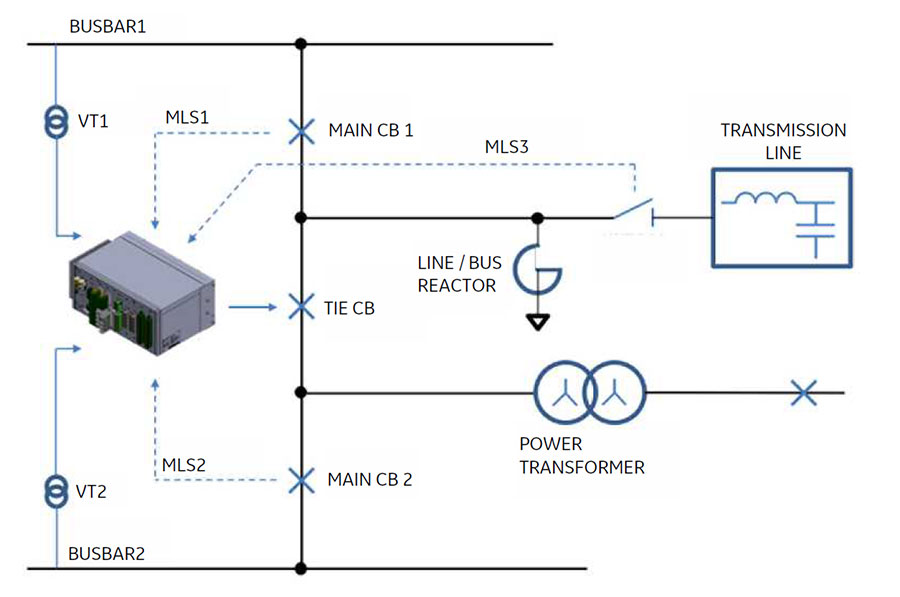 Example of multiple load switching. Circuit breaker may be used to switch line or reactor or a power transformer.
Example of multiple load switching. Circuit breaker may be used to switch line or reactor or a power transformer.
